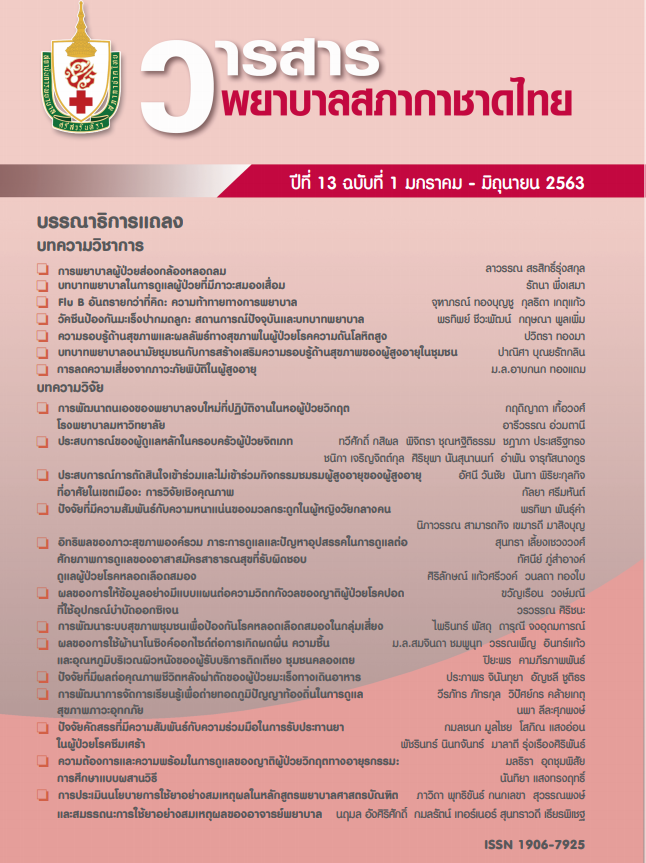Factors Related to Bone Mineral Density in Middle-Aged Women
Keywords:
menstruation, life stress, behavior to prevent osteoporosis, bone mineral density middle-age-womenAbstract
This study is a descriptive correlational research design aiming to evaluate the factors related to bone mineral density in middle-aged women. The sample group was 40-60 year old women that were referred for bone mineral density by the Dual Energy X-ray Absorptiometry (DXA) at the Nuclear medicine Unit at King Chulalongkorn Memorial Hospital, the Thai Red Cross Society. Simple random sampling was used to recruit 193 samples. The research instruments consisted of Personal Information Questionnaire, Life Stress Questionnaire, Osteoporosis Preventive Behavior Questionnaire and the weight record form, the results of the examination of bone mineral density and interpretation. Life stress questionnaire and Osteoporosis preventive behavior questionnaire with Cronbach's alpha coefficient of .81 and .80. The data were analyzed by using statistics for descriptive, independent t-test, and Pearson's product moment correlation coefficient.
The results of this study showed that samples had low level of life stress (M = 14.30, SD = 5.60), moderate level of osteoporosis prevention behavior (M = 67.29, SD = 8.42), and 55.4 % had osteopenia. The mean score on bone mineral density of the menopause group was significantly higher than those in the menopause group (t = 7.409, p < .05). Life stress was significantly negative correlated in a low level with bone mass density (r = -.219, p < .01) and preventive behaviors of osteoporosis was significantly positive correlated in a low level with bone mass density (r = .168, p < .05).
References
2. Pongchaikul C. Textbook of Osteoporosis 1. Bangkok: Holistic publishing; 2009.
3. Rojanasthien S, Songpatanasilp T. Definition, epidemiology, etiology and burden of osteoporosis. In: Taechakraichana N. Guideline in management of osteoporosis. Bangkok: Thaiosteoporosisfoundation; 2017. p. 1-10. (in Thai)
4. Wongsuttilert A, Chanchai S, Jaidee W. Risk factor affecting bone health in middle-age group. In: Proceedings of the Burapha University International Conference 2015, Moving Forward to a Prosperous and Sustainable Community; 2015. Jul 10-12; Chonburi: Burapha University; 2015. p. 304-12.
5. Buatee S, Siriwatanamethanon J, Sindhu S. Cardiovascular Prevention Behaviors among Middle-aged Women Living in Banladsrabua Yangtalad District, Kalasin Province, Thailand. J Nurs Sci 2012;30(2):58-69. (in Thai)
6. Sinsoongsud T, Piaseu N. Factors predicting preventive behavior for osteoporosis in university students. Rama Nurs J 2015;21(2):244-58.
7. Pender NJ, Murdaugh CL, Parsons MA. Health promotion in nursing practice. 5th ed. New Jersey: Pearson Education; 2006.
8. Silva ACV, Rosa MI, Fernandes B, Lumertz S, Diniz RM, Damiani MEFR. Factors associated with osteoporosis with osteopenia and osteoporosis in women undergoing bone mineral density test. Rev Bras Reumatol 2015;55(3):223-8.
9. Francucci CM, Romagni P, Camilletti A, Fiscaletti P, Amoroso L, Cenci G, Morbidelli C, Boscaro M. Effect of natural early menopause on bone mineral density. Maturitas 2008;59(4):323-8.
10. Potup P, Weerawitporn K, Klainak K, Piyarattanapan C, Pankla R. The association between bone mineral density and biochemical bone turnover markers in women at Thapho District, Phitsanulok Province. Songkla Med J 2014;32(2):63-72. (in Thai)
11. Charoenphandhu N. Chronic psychological stress is a risk for osteoporosis. TSRI Research Community 2015;124:2-5. (in Thai)
12. Erez HB, Weller A, Vaisman N, Kreitler S. The relationship of depression, anxiety and stress with low bone mineral density in post-menopausal women. Arc Osteoporos 2012;7:247-55.
13. Wippert P. Rector M, Kuhn G, Wuertz-Kozak, K. Stress and alteration in bones: an interdisciplinary perspective. Frontiers in Endocrinology 2017;8(96):1-7.
14. Chapha M, Priyatruk P, Sitipongsakul S, Moopayak K. Predicting factors of preventive behavior of osteoporosis in nurses. J Nurs Sci 2010;28(3):50-9. (in Thai)
15. Kadam N, Chiplonkar S, Khadiker A, Divate U, Khadike V. Low bone mass in urban Indian women above 40 years of age: Prevalence and risk factors. Gynecol Endocrinol 2010;26(12):1-9.
12. Srisatidnarakul B. The methodology in nursing research. Bangkok: U&I Inter media; 2010. (in Thai)
17. Cohen S, Kamarck T, Mermelstein R. A global measure of perceived stress. J Health Soc Behav 1983;24(4):385-96.
18. Wongpakaran N, Wongpakaran T. Thai version of the PSS-10: an investigation of its psychometric properties. BioPsychoSocial Med 2010;4(6):1-6
19. Rrasitphol N. Effects of the application of health belief model on osteoporosis prevention behavior among premenopausal women in Uthong district, Suphanburi province [dissertation]. Bangkok: Mahidol University; 2000.
20. Ott S. Bone density [Internet]. 2002 [cited 2018 May 12]. Available from http://courses.washington.edu/bonephys/opFxRisk.html
21. Youngcharoen P, Aree-Ue S, Malathum P. Selected factors predicting osteoporosis preventive behavior among nursing personnel. Rama Nurs J 2011;17(1):1-19. (in Thai)
22. Karoonngamphan M, Suvaree S, Numfone N. Health behaviors and health status of workers: a case study of workplaces in Sathorn district, Bangkok Metropolitan. Songklanagarind J Nurs 2014;32(3):51-66.
23. National Statistical Office. Survey of smoking and drinking in 2007 [Internet]. 2012 [cited 2019 Mar 28]. Available from: https://www.thaihealth.or.th/Content/20317-202550.html (in Thai)
24. Rakthao D, Kosai P, Wicha T, Jongpongsa S, Tantong P. Consumer behavior of fresh coffee in Tha Sala district, Nakhon Si Thammarat province. Veridian E-Journal, Silpakorn University 2018;11(3):1906-3437. (in Thai)
25. Sangworawong N. Osteoporosis in aging. 5th ed. Bangkok: Wuttiphan-printing; 2005. (in Thai)
26. Kumono H. Osteoporosis and stress. Clin Calcium 2005;15(9):1544-7.
27. Jeihooni AK, Hidermia A, Kaveh MH, Hajizadeh E. The effect of prevention program based on health belief model on osteoporosis. J Res Health Sci 2015;15(1):47-53.
Downloads
Published
Issue
Section
License
เนื้อหาบทความหรือข้อคิดเห็นต่างๆ ในวารสารพยาบาลสภากาชาดไทยนี้ เป็นความคิดเห็นของผู้เขียนบทความ ไม่ใช่ความเห็นของกองบรรณาธิการ หรือสถาบันการพยาบาลศรีสวรินทิรา สภากาชาดไทย






